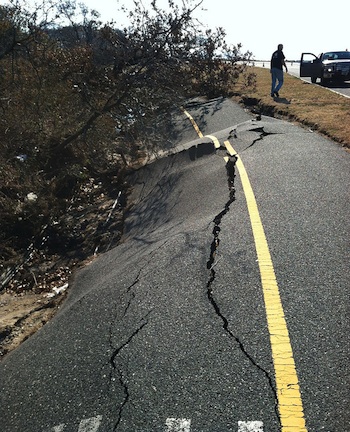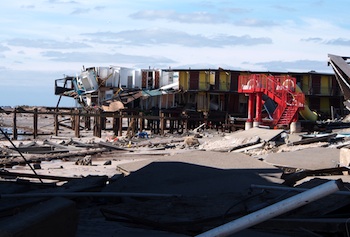Editor's note: Nearly five months after Hurricane Sandy battered and bruised the Eastern Seaboard, the disarray the storm delivered across many units of the National Park System continues to be cleaned up. Some damage remains to be discovered. In this story, the Traveler takes a look at how Gateway National Recreation Area in the New York-New Jersey metropolitan area fared.
Photographic slides paper-clipped to strings to dry out. Officer's Row at Fort Hancock propped up with two-by-fours. Multi-use paths ripped out in places and buried in sand elsewhwere. That was part of the aftermath from Hurricane Sandy at Gateway National Recreation Area.
Restoring order at Gateway is not simply, or quickly, done. Phone service still is out at Floyd Bennett Field. Sandy Hook, Jacob Riis Park, and Fort Tilden, including Breezy Point tip, remain closed, and the growl of front-end loaders can be heard at Sandy Hook as acres and acres and acres of sand the storm swept onto the Hook are cleared away.
"There's going to be a wealth of information that needs to be analyzed about what this means and what do you do," said Linda Canzanelli, Gateway's superintendent, when talk turns to how the National Park Service moves forward in restoring order in light of the very real potential for similar storms down the road.
Should well-worn buildings be allowed to vanish? How should access be restored to places like Fort Tilden in Gateway's Jamaica Bay Unit where the Shore Road was destroyed? Do you simply rebuild, or rebuild with an intent to somehow minimize the impacts of future storms?
"I think there are numerous answers to that question," replied the superintendent. "The one answer on anything that's a modern addition, such as the Shore Road in Fort Tilden, it's fairly easy to make a decision that we're not rebuilding, so that has a significant impact to park visitors. That road provided some easy access to wonderful fishing locations along the outer shore there.
"We're not going to rebuild Shore Road, but how do we provide that kind of easy access?," said Superintendent Canzanelli, pointing out that surf casters have a lot of equipment to haul out to, and back from, the beach. "Surf-fishing equipment weighs a ton, and then when you get the catch limit size on stripers, and the cooler needed for the fish that you've caught. You don't want to turn it into just a young, able person's sport because lugging that stuff across soft sand is a Herculean task."

Photographic slides from Sandy Hook archives were dried out by hanging them wherever possible. NPS photo.
A Costly Storm
Of the Eastern Seaboard parks hit by Hurricane Sandy, Gateway sustained the greatest amount of damage from a dollar standpoint. The supplemental appropriations bill passed by Congress in January carried $180 million for the NRA, though even that might not be enough. That figure was calculated by the National Park Service's Facility Management Team that visited the NRA after the hurricane last October to assess damage.
"Yes, there's a lot of road damage, there's a lot of dock damage, there's bike path damage, there's roof damage," said Superintendent Canzanelli. "Just Sandy Hook alone, the early, short easy estimate was there was 20,000 dumptrucks worth of sand that has to be moved. So, you put all of those cumulative together with Jamaica Bay and Staten Island and Sandy Hook, the 20,000 acres of Gateway, and it rolls up to that number."
However, she went on, "Part of the challenge is we don't honestly even know all of the things that need to be done because we haven't yet been able to even uncover all of the areas that have been affected. Some of the areas are still covered with sand."
Plus, some initial solutions to guard against future storms have turned out to be much, much more costly than expected. For instance, at historic Fort Hancock on Sandy Hook, while the late-19th Century buildings on Officer's Row didn't greatly suffer structural damage, when water flooded their basements it upended tanks full of heating oil. That oil subsequently leaked and led to damage.
While Superintendent Canzanelli thought the obvious solution would be to move the heating and ventilation systems from the buildings' basements to the first floor, the cost proved untenable.
"That sounds like a fine and sane and reasonable thing," she said of the proposal to move the HVAC units to the first floor, "but I got some price estimates, and it's $80,000 (per building) to move them out of the basement. It costs $15,000 to replace them in the basement.

Water from the ocean eroded the sand beneath the Sandy Hook multi-use path, causing portions of it to buckle and collapse. NPS photo.
"So, the question is, if you only have 6 inches of flooding in the building, maybe you put them back in the basement, but you put them a foot off the floor," the superintendent added.
"So, some pronouncements that I'd been making early on, now I'm like, 'Is that really the best way to do it?' And you almost have to look at every place on a case-by-case basis. If you're talking about a headquarters building, or if you're talking about the wastewater treatment plant, yes, it's probably worth it to spend the larger number in order to make sure those systems can be back up and running in a week vs. a year.
"But if you're talking about a building that's being used for a non-critical kind of thing, do you need to spend that larger amount of money?"
A Gazillion Questions
While Gateway has some 600 historic structures, structures the park has a mandate to preserve, snap decisions can't be made to simply demolish some that would cost an exorbitant amount to restore. To sort through what can and can't be done, park staff have been working on sorting the structures into one of three categories: those facilities to be maintained in a good or excellent condition, those to be maintained in their current condition, which might not be full restoration, and those that might continue to deteriorate.
"I think one of the things that we're going to have to do after we finish that banding exercise, which we're doing as part of our general management plan, is look at it again using sea-level rise," said Superintendent Canzanelli, mindful of climate change and its impacts. "Then you have to decide, do you take extraordinary measures on some of these things, or do you then let things which were fundamental resources deteriorate? And part of that is going to need a larger analysis. Does Gateway have the only one of these (types of structures)? Or are there 10 examples in the Park Service and 30 examples across the country?
"So the cultural resource question becomes a lot more difficult."

The tidal surge carved out the sea-facing portions of the Silver Gull Beach Club at Fort Tilden. NPS photo.
And part of the difficulty is the fact that Gateway just does not have the financial wherewithal to protect and preserve all of the cultural resources in the NRA, she said.
Moving forward, Gateway's staff is taking a good look around their landscapes to see what fared well through the storm, and what didn't. But the superintendent is hesitant to simply jump on any one approach to rebuilding with future storms in mind without having analyzed it.
"I'd love some peer-reviewed science that actually looked at what we are trying to accomplish, and what are some of the best ways of doing it," she said. "I guess the question is, is Jamaica Bay (with its wildlife refuge and natural setting) the answer, or is the barrier peninsula of Rockaway the answer? Where do you need the protection, and what role did the (Raritan) bay play in Sandy?
"I have a gazillion questions and no answers. The natural systems did well. Where the marsh islands that have been restored within Jamaica Bay, they look like they did well with the inundation that occurred, and the area that had the marsh fringe. Places like Crooke's Point and Great Kills, I was out there the week of Sandy and you wouldn't even have known that there had been a hurricane. It was perfectly fine. But there's no wetland fringe around that area. Is it because that area is able to roll in a more natural way? These are all fascinating questions.
"I'm hoping that the money allows us flexibility so we don't have to do things just the way it is."
Coming Sunday: Suggestions and support from stakeholders.










Add comment